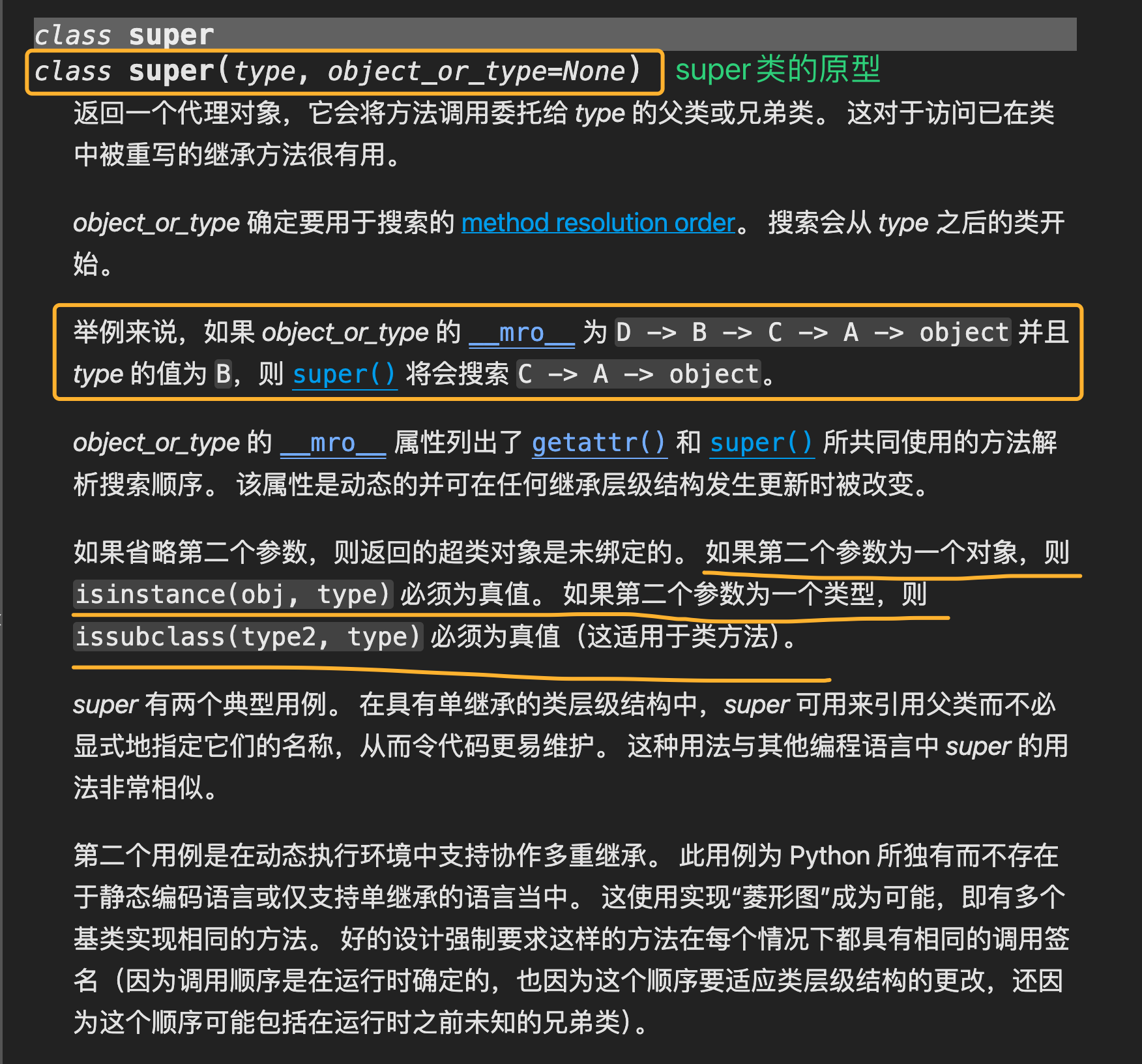Python 中 mro 链在 super 调用中的应用
原创Python 中 mro 链在 super 调用中的应用
原创
密码学人CipherHUB
发布于 2024-05-22 14:48:19
发布于 2024-05-22 14:48:19
代码可运行
运行总次数:0
代码可运行
简单的super类使用
class A(object):
def __init__(self):
print(self.__class__, 'A init')
class B1(A):
def __init__(self):
# 效果等同于 super(B1, self).__init__()
# 参考 class B2
super().__init__()
print(self.__class__, 'B1 init')
if __name__ == '__main__':
print(B1.mro())
B1()代码运行的效果:

单继承时 super 调用的效果
此时对 B1 来说,它的 mro 调用链是:B1 --> A --> object
而 super().__init__()的效果其实等同于:super(B1, self).__init__()
super 调用的等同效果
class A(object):
def __init__(self):
print(self.__class__, 'A init')
class B1(A):
def __init__(self):
# 效果等同于 super(B1, self).__init__()
# 参考 class B2
super().__init__()
print(self.__class__, 'B1 init')
class B2(A):
def __init__(self):
# 等同于 super().__init__()
super(B2, self).__init__()
print(self.__class__, 'B2 init')
class B3(A):
def __init__(self):
# 等同于 super().__init__()
# 等同于 super(B3, self).__init__()
# 这里不直接写基类 A,是因为未来继承的基类可能会变化
# super会根据 mro 自动追踪基类
A.__init__(self)
print(self.__class__, 'B3 init')
if __name__ == '__main__':
print(B1.mro())
B1()
print('-' * 16)
print(B2.mro())
B2()
print('-' * 16)
print(B3.mro())
B3()B1、B2、B3三个类都继承自 A,在使用 super 时,三种写法:
super().__init__()
super(B2, self).__init__()
A.__init__(self)
效果其实是等同的:

效果等同的 super 调用链
super 类中的 type 参数对 mro 链与 super 对基类的调用顺序的影响
官方说明
在官方文档https://docs.python.org/zh-cn/3/library/functions.html#super中对 super 类做了一个说明:

super 类的说明
从官方文档中可以看出来,super 其实是一个类,其原型为:
class super(type, object_or_type=None)
继承链下的 mro 与 super 调用顺序
class A(object):
def __init__(self):
print(self.__class__, 'A init')
class B(A):
def __init__(self):
super().__init__()
print(self.__class__, 'B init')
class C1(B):
def __init__(self):
# super的 mro 决定了__init__()的链式调用顺序
super(C1, self).__init__()
print(self.__class__, 'C1 init')
class C2(B):
def __init__(self):
# 如果第一个参数传入的是父类型 B,那么 mro 将会首先从父类 A 开始执行
super(B, self).__init__()
print(self.__class__, 'C2 init')
if __name__ == '__main__':
print(C1.mro())
C1()
print('-' * 16)
print(C2.mro())
C2()这段代码中:
B继承自AC1和C2均继承自B- 在
C1的__init__()中显式指定了super(C1, self).__init__(),首先执行的是B.__init__(self) - 在
C2的__init__()中显式指定了super(B, self).__init__(),首先执行的是A.__init__(self) super 第一个参数决定了 mro 查找类的起始位置
super 第一个参数决定了 mro 查找类的起始位置
对于成员函数也遵守这一套调用顺序规则
class A(object):
def hello(self):
print(self.__class__, 'A hello')
class B(A):
pass
class C(B):
def hello(self):
print(self.__class__, 'C hello')
class D(C):
def hello1(self):
super().hello()
def hello2(self):
super(D, self).hello()
def hello3(self):
super(C, self).hello()
def hello4(self):
super(B, self).hello()
if __name__ == '__main__':
print(D.mro())
print('-' * 16)
d = D()
d.hello()
print('-' * 16)
d.hello1()
print('-' * 16)
d.hello2()
print(D.mro())
print('-' * 16)
print(C.mro())
d.hello3()
print('-' * 16)
print(B.mro())
d.hello4()
继承链路中super对成员函数调用顺序的影响
super类中的第二个参数对函数调用的影响
第二个参数作为对象传入时
class A(object):
def __init__(self, name: str):
print(self.__class__, 'A hello: {}'.format(name))
class B(A):
def __init__(self, name: str, greetings: str):
super(B, self).__init__(name)
print(self.__class__, 'B hello:{} {}'.format(name, greetings))
class C1(B):
def __init__(self, name: str, greetings: str):
super(B, self).__init__(name, greetings)
print(self.__class__, 'C1 hello:{} {}'.format(name, greetings))
if __name__ == '__main__':
print(C1.mro())
C1('C1', 'morning')
第二个参数作为对象时调用基类成员函数
- 上面的代码中
C1继承自B,而B继承自A A的初始化函数为:def __init__(self, name: str)C1和B的初始化函数为:def __init__(self, name: str, greetings: str),在入参上有明显区别- 在
C1的初始化函数中,显式的指定了super(B, self).__init__(name, greetings), 其中的 self 指向的是C1的实例化对象,但是在调用链上,mro 需要去寻找的基类确是A,因为此时的 mro 调用链为:[<class '__main__.C1'>, <class '__main__.B'>, <class '__main__.A'>, <class 'object'>]基类的起始位置在A - 而
A的初始化函数为:def __init__(self, name: str),只接受一个入参,因此在执行时,程序会抛出异常:TypeError: A.__init__() takes 2 positional arguments but 3 were given
指定第二个参数为第一个参数的子类对象
class A(object):
def __init__(self, name: str):
print(self.__class__, 'A hello: {}'.format(name))
class B(A):
def __init__(self, name: str, greetings: str):
super(B, self).__init__(name)
print(self.__class__, 'B hello:{} {}'.format(name, greetings))
class C1(B):
def __init__(self, name: str, greetings: str):
# super
super(B, self).__init__(name, greetings)
print(self.__class__, 'C1 hello:{} {}'.format(name, greetings))
class C2(B):
def __init__(self, name: str, greetings: str):
super(C2, self).__init__(name, greetings)
print(self.__class__, 'C2 hello:{} {}'.format(name, greetings))
if __name__ == '__main__':
print('-' * 8)
print(C2.mro())
# super 也可以在函数中使用
# C2实例为 B 的子类对象
# super 第一个参数决定了从 mro 链的哪个位置开始查找
# 第二个参数决定了使用哪个对象去调用自身或基类的成员函数
# 第二个参数必须为第一个参数的类型或者子类
super(B, C2(name = 'tmp_c2', greetings = 'greet_c2')).__init__(name = 'test_A')
实力对象执行基类函数
指定第二个参数为第一个参数的子类类型
class ParentA:
@classmethod
def foo(cls):
print("ParentA.foo called")
class ParentB(ParentA):
@classmethod
def foo(cls):
print("ParentB.foo called")
class Child(ParentB):
@classmethod
def foo(cls):
# Child 类最终调用ParentA的foo方法
super(ParentB, Child).foo()
print("Child.foo called")
if __name__ == '__main__':
print(Child.mro())
# 调用Child的foo方法
Child.foo()
指定第二个参数为子类而非子类对象
总结
super 类的使用有以下几种常见方式:
super()不带任何参数,这种方式等同于super(type, self)super(type)只带一个类型参数,第二个参数默认为 self 所指的实例对象super(type, obj)既指定类型,又指定对象super(type, type2)第二个参数指定为类型
总的来说,Python 3 中推荐使用不传任何参数的 super() 调用方式,因为它更简洁,而且可以避免一些错误。
在多重继承的情况下,super() 函数可以确保所有父类的方法都被正确调用,遵循方法解析顺序(MRO)。
原创声明:本文系作者授权腾讯云开发者社区发表,未经许可,不得转载。
如有侵权,请联系 cloudcommunity@tencent.com 删除。
原创声明:本文系作者授权腾讯云开发者社区发表,未经许可,不得转载。
如有侵权,请联系 cloudcommunity@tencent.com 删除。
评论
登录后参与评论
推荐阅读
目录

